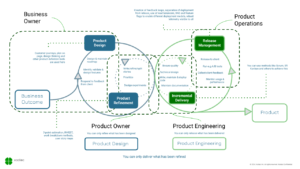Effective product delivery is a constant challenge in today’s dynamic business world. Whether embracing agile methodologies, implementing DevOps practices, or following traditional project management approaches, one common thread runs through them all: the need to manage risk. Contingency planning is a pivotal element in risk management, and understanding the distinction between real and perceived risks is crucial for success. In this article, we’ll delve into the world of product delivery, risk assessment, and the importance of addressing risks early to ensure the smooth execution of your initiatives.
Real Risks vs. Perceived Risks
Distinguishing between the two is fundamental for effective risk management.
Real Risks are those that pose a tangible and quantifiable threat to your success. These risks can potentially disrupt timelines, budgets, or overall project objectives. For instance, if a critical feature is not delivered on time, it may lead to the loss of a customer to a competitor. Identifying and addressing real risks is imperative for safeguarding your value delivery and success.
Perceived Risks, on the other hand, are risks based on unfounded assumptions, misconceptions, or a lack of information. For example, a team’s reluctance to adopt a particular approach, believing it to be against company policy, when the organization’s rules actually do not prohibit it. Addressing these perceived risks is crucial for fostering a culture of adaptability and innovation within your team.
The Impact and Likelihood Matrix
Assessing potential risks is an essential step in any project or business. One effective tool for ranking risks is the Impact and Likelihood Matrix. It evaluates the possible impact of a given risk and the likelihood of its occurrence. By doing so, you can determine the importance of addressing the risks and the mitigation plan or timeframe required.
The Matrix categorizes risks based on their likelihood and impact, ranging from high to low. High-likelihood and high-impact risks should be given top priority and addressed as soon as possible. Conversely, low likelihood and low impact risks have the lowest priority. By using this matrix, you can prioritize the risks and develop an effective contingency plan.
Best Practices to Mitigate Risks
Understand the context
It’s crucial to find solutions and techniques that are compatible with your program, your organization’s culture, and your context to mitigate any risks. Some leaders make the mistake of assuming that if a plan works for one company, it will work for their organization as well. However, every organization has its unique context, including complex processes, people, culture, and tools, and what worked for another organization may not work for yours, and it could even harm your program. Therefore, it’s important to customize the plan to fit your organization’s specific needs.
Address Early: The Value of Early Risk Mitigation
Addressing risks at the earliest stages of a project or business venture helps its success and longevity tremendously. Early risk management not only guards against possible setbacks but also adds significant value by promoting a proactive and strategic approach. By identifying and analyzing potential challenges at the outset, organizations can create sturdy contingency plans, allocate resources more efficiently, and improve overall project resilience.
Imagine a company is working on a new e-commerce platform. During the early stages of the project, the team identified a potential risk related to the third-party payment process. They conducted a thorough analysis and discovered that recent changes being proposed in payment regulations could cause delays. They take proactive measures to:
Establish communication channels with regulatory bodies to keep them up to date with upcoming changes
They separate out the affected modules, delaying their updates so they reduce potential rework
They put additional funds aside in case the risk is realized and additional work is required
Small Changes
When you plan on making changes to your business processes or culture, it is important to keep in mind that bigger changes carry bigger risks. To mitigate these risks, it is recommended to start with small changes first. This way, if something doesn’t go as planned or an unexpected issue arises, the impact will be minimal. You can use these small changes as an opportunity to learn and improve rather than experience major setbacks.
Conclusion
Managing risks effectively is an essential aspect of strong leadership in any business environment. Leaders must be able to identify potential risks and develop strategies to mitigate them to ensure the safety and success of their organization. Being proactive in addressing risks and implementing contingency plans can help your organization and your teams thrive when unexpected events occur.
While it’s important to pay close attention to risk management, you should also consider if you are spending too much time on unnecessary contingency planning, hedging against events that may never occur. However, it’s equally important to strike a balance between being prepared and being over-prepared. Too much contingency planning can be counterproductive and may lead to unnecessary expenses, delays, and decreased efficiency. When you spend too much time and resources on contingency planning, you may lose sight of your goals and become too risk-averse, which can hinder your organization’s growth and innovation. Moreover, excessive contingency planning can create a false sense of security and lead you to believe that you have covered all possible risks, which is rarely the case. Therefore, it’s essential to prioritize your risks and focus on the ones that are most likely to occur and have the most significant impact on your business. By doing so, you can allocate your resources more efficiently and effectively and ensure that your contingency plans are tailored to your specific needs and context.
To navigate the complex world of product delivery successfully, Xodiac provides valuable services to ensure your contingency plans are in place, are appropriate for the risks you face, and are effectively managing risk. You can learn more about our services by visiting our website or sending us an email to develop a risk-based roadmap.




